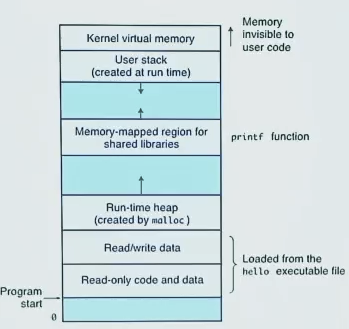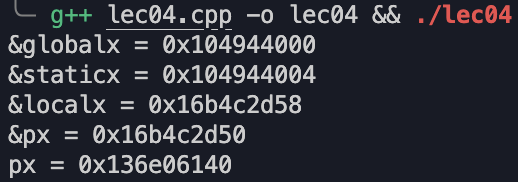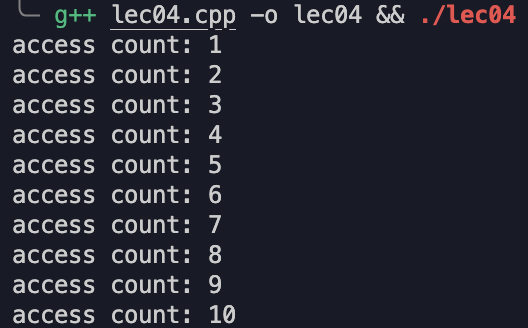Chapter 03 : Memory Model
📖 阅读信息
1 分钟 | 150 | 156
Lead-in
int a ; // Global Vars.
static int b ; // Static Global Vars.
void f (){
int k ; // Local Vars.
static int l ; // Static Local Vars.
int * p = malloc ( sizeof ( int )); // Allocated Vars.
}
上面的程序展现了 C++ 中的四种变量类型,也是这个章节需要介绍的部分
Memory Layout
上面的图展示了程序在内存中的布局,其中:
Stack:存放函数的局部变量
Heap:存放动态分配的内存
Code / Data:存放全局变量,静态全局变量和静态局部变量
Example
我们可以写个程序来看不同类型变量的地址:
#include <cstdlib>
#include <iostream>
using namespace std ;
int globalx = 10 ;
int main (){
static int staticx = 3 ;
int localx = 5 ;
int * px = ( int * ) malloc ( sizeof ( int ));
cout << "&globalx = " << & globalx << endl ;
cout << "&staticx = " << & staticx << endl ;
cout << "&localx = " << & localx << endl ;
cout << "&px = " << & px << endl ;
cout << "px = " << px << endl ;
free ( px );
return 0 ;
}
运行结果如下:
可以看到,静态全局变量和全局变量的地址是比较接近的,而局部变量和指针(普通的局部变量)是比较接近的,指针动态分配的地址是比较远的。
Global Vars
Static(静态)一词关键体现在两个方面:永久的存储和受限的访问范围
静态全局变量只能在定义它的编译单元(即一个 .cpp 文件)中使用,不能在其他编译单元中使用
Example
我们把上面的 Lec04_1.cpp 修改一下:
Lec04_1.cpp static int globalx = 10 ;
static double pi (){
return 3.14 ;
}
此时再次进行编译,会发现报错:
Static Local Vars
静态局部变量只会在第一次调用函数时初始化,之后不会再次初始化,它会在多次调用函数时保持状态
Example
#include <cstdlib>
#include <iostream>
using namespace std ;
void access_count (){
static int count = 0 ;
cout << "access count: " << ++ count << endl ;
}
int main (){
for ( int i = 0 ; i < 10 ; i ++ )
access_count ();
return 0 ;
}
编译运行结果如下:
这说明静态局部变量在函数调用之间是保持状态的,每次调用函数时,静态局部变量的值不会进行初始化。这是因为静态局部变量的存储位置在全局数据区,而不是栈上,所以不会被释放
Pointers to Objects
假设我们有:
string s = "hello" ;
string * ps = & s ;
Operators with pointers
我们也可以通过 *ps 来访问 s 这个对象,继而访问其成员函数:
string * ps = & s ;
int len = ( * ps ). length (); // Get the length of string
int len = ps -> length (); // Equivalent to the above
Two Ways to Access
string s ; // 定义一个字符串对象,并且也被初始化了
string * ps ; // 定义一个指向字符串对象的指针,但是并没有初始化
Assignment
string s1 , s2 = "hello" ;
s1 = s2 ; // Copy the value of s2 to s1
string * ps1 , * ps2 ;
ps1 = ps2 ; // Copy the address of ps2 to ps1
Defining References
char c ; // A character
char * p = & c ; // A pointer to a character
char & r = c ; // A reference to a character
用 type& refname = name 可以为名为 name 的变量起一个别名 refname
这里的 r 是 c 的别名,修改 r 也会修改 c 的值,即用 r 就是在用 c,用 c 就是在用 r
在函数的参数表 / 成员函数中使用引用也可以写为 type& refname,由函数调用者或者是类建立者来初始化
引用并非是一个新的变量,而是一个已经存在的变量的别名,所以对一个引用的指针是不合法的,但是对一个指针的引用是合法的,也不存在一个引用的数组
int &* p ; // Illegal
void f ( int *& p ); // OK
Dynamic Memory Allocation
在 C++ 中,我们可以使用 new 和 delete 来动态分配和释放内存
int * p = new int ; // Allocate memory for an integer
int stash = new Stash ; // Allocate memory for a Stash object
int * arr = new int [ 10 ]; // Allocate memory for an array of 10 integers
delete p ; // Release memory for an integer
delete stash ; // Release memory for a Stash object
delete [] arr ; // Release memory for an array of 10 integers
思考
既然 new 和 delete 可以动态分配和释放内存,那么 malloc 和 free 呢?它们也可以动态分配和释放内存,那么它们之间有什么区别呢?
事实上,new 和 delete 能使得对象的构造函数和析构函数得到正确的调用:
#include <cstdlib>
#include <iostream>
using namespace std ;
struct Student {
int id ;
Student (){
id = 0 ;
cout << "Student::Student()" << endl ;
}
~ Student (){
cout << "Student::~Student()" << endl ;
}
};
int main (){
Student * ps1 = ( Student * ) malloc ( sizeof ( Student ));
cout << "ps1->id = " << ps1 -> id << endl ;
Student * ps2 = new Student ;
cout << "ps2->id = " << ps2 -> id << endl ;
free ( ps1 );
delete ps2 ;
return 0 ;
}
运行可以得到如下结果:
看起来 ps1 也得到了正确的结果,但是事实上并非如此,我们加 O2 优化编译选项:
很明显能看出,new 和 delete 能够正确调用对象的构造函数和析构函数,而 malloc 和 free 则不能(甚至是初始化也不行)
Tips
不要将 malloc & free 与 new & delete 混用
一定要记得释放动态分配的内存,否则会造成内存泄漏
一般情况下,程序结束时会自动释放内存,但是如果是长时间运行的程序(或者是一直无法结束的程序),那么内存将会无限制的增长,最后导致崩溃
不要重复释放内存,否则会造成程序崩溃
当我们使用 new 分配单个对象时,使用 delete;当我们使用 new[] 分配数组时,使用 delete[]
delete 一个空指针是安全的
Constant
我们使用 const 来定义一个常量,它的值在程序运行时不能被修改
const int x = 123 ;
x = 27 ; //Illegal!
x ++ ; //Illegal!
int y = x ; // ok, copy const to non-const
y = x ; // ok, same thing
const int z = y ; // ok, const is safer
常量的作用域和普通变量相同
常量在 C++ 中默认为内部链接(Internal Linkage),即在编译器中只是符号表的一个记录,并不是一个真正的变量
常量必须在定义时初始化,除非是 extern 声明的外部常量
Pointers with Const
int a [] = { 53 , 54 , 55 };
int * const p = a ; // p is const
* p = 20 ; // OK
p ++ ; // ERROR
const int * p = a ; // (*p) is const
* p = 20 ; // ERROR
p ++ ; // OK
const int *p 表示指针指向的内容是常量,指针本身是可以改变的int * const p 表示指针本身是常量,指针指向的内容是可以改变的
Example
int i ;
const int ci = 10 ;
int * ip ;
const int * cip ;
ip = & i ; // OK
ip = & ci ; // ERROR
cip = & i ; // OK
cip = & ci ; // OK
* ip = 54 ; // OK
* cip = 54 ; // ERROR
其中 ip = &ci 是错误的,因为 ip 是一个普通的指针,而 ci 是一个常量,绑定之后不能通过指针修改常量的值
对于 char 的字符数组来说,char *s 和 const char *s 是等价的,所以我们对于 char *s 定义的字符串也是不能修改的,如果需要修改,需要使用 char s[] 来定义
这是因为 s[] 定义在栈上,而 *s 定义在代码段中(是只读的,无法修改)
Example
#include <cstdlib>
#include <iostream>
using namespace std ;
int main (){
const char * s1 = "Hello, World!" ;
char s2 [] = "Hello, World!" ;
cout << ( void * ) s1 << endl ;
cout << ( void * ) s2 << endl ;
cout << ( void * ) main << endl ;
return 0 ;
}
可以看到最终结果:
💬 评论







